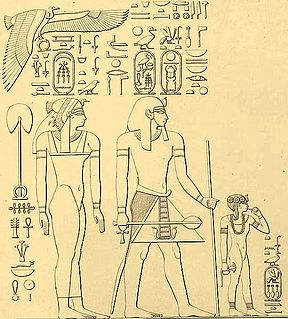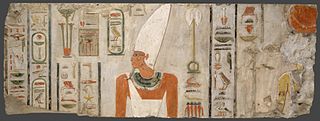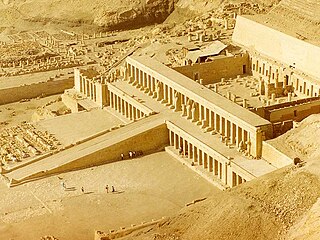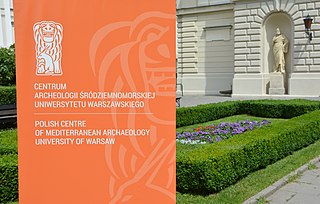Related Research Articles

Hatshepsut was the fifth pharaoh of the Eighteenth Dynasty of Egypt. She was the second historically confirmed female pharaoh, the first being Sobekneferu.
The 1470s BC was a decade lasting from January 1, 1479 BC to December 31, 1470 BC.

Ahmose was an ancient Egyptian queen in the Eighteenth Dynasty. She was the Great Royal Wife of the dynasty's third pharaoh, Thutmose I, and the mother of the queen and pharaoh Hatshepsut. Her name means "Born of the Moon".

Thutmose I was the third pharaoh of the 18th Dynasty of Egypt. He received the throne after the death of the previous king, Amenhotep I. During his reign, he campaigned deep into the Levant and Nubia, pushing the borders of Egypt farther than ever before. He also built many temples in Egypt, and a tomb for himself in the Valley of the Kings; he is the first king confirmed to have done this.

Thutmose II was the fourth Pharaoh of the Eighteenth Dynasty of Egypt. His reign is generally dated from 1493 to 1479 BC. His body was found in the Deir el-Bahri Cache above the Mortuary Temple of Hatshepsut and can be viewed today in the Egyptian Museum in Cairo.

Senenmut was an 18th Dynasty ancient Egyptian architect and government official. His name translates literally as "mother's brother."

Deir el-Bahari or Dayr al-Bahri is a complex of mortuary temples and tombs located on the west bank of the Nile, opposite the city of Luxor, Egypt. This is a part of the Theban Necropolis.

Mentuhotep II, also known under his prenomen Nephepetre, was an ancient Egyptian pharaoh circa 2061–2010 BCE, the sixth ruler of the Eleventh Dynasty. He is credited with reuniting Egypt, thus ending the turbulent First Intermediate Period and becoming the first pharaoh of the Middle Kingdom. He reigned for 51 years, according to the Turin King List. Mentuhotep II succeeded his father Intef III on the throne and was in turn succeeded by his son Mentuhotep III.

Mortuary temples were temples that were erected adjacent to, or in the vicinity of, royal tombs in Ancient Egypt. The temples were designed to commemorate the reign of the Pharaoh under whom they were constructed, as well as for use by the king's cult after death.

Tomb KV60 in Egypt's Valley of the Kings is one of the more perplexing tombs of the Theban Necropolis, due to the uncertainty over the identity of one female mummy found there (KV60A). She is thought by some, such as the Egyptologist Elizabeth Thomas, to be that of the Eighteenth Dynasty pharaoh Hatshepsut. This identification has been advocated by Egyptologist Zahi Hawass.

KV20 is a tomb in the Valley of the Kings (Egypt). It was probably the first royal tomb to be constructed in the valley. KV20 was the original burial place of Thutmose I and later was adapted by his daughter Hatshepsut to accommodate both her and her father. The tomb was known to the Napoleonic expedition in 1799, but a full clearance of the tomb only was undertaken by Howard Carter in 1903, although it had been visited by several explorers between 1799 and 1903. KV20 is distinguished from other tombs in the valley, both in its general layout and because of the atypical clockwise curvature of its corridors.

Ahhotep I was an ancient Egyptian queen who lived circa 1560–1530 BC, during the end of the Seventeenth Dynasty of Egypt. She was the daughter of Queen Tetisheri and Senakhtenre Ahmose, and was probably the sister, as well as the queen consort, of Pharaoh Seqenenre Tao ll. Ahhotep I had a long and influential life. She ruled as regent for her son Ahmose I for a time.

The Mortuary Temple of Hatshepsut, also known as the Djeser-Djeseru, is a mortuary temple of Ancient Egypt located in Upper Egypt. Built for the Eighteenth Dynasty pharaoh Hatshepsut, who died in 1458 BC, the temple is located beneath the cliffs at Deir el-Bahari on the west bank of the Nile near the Valley of the Kings. This mortuary temple is dedicated to Amun and Hatshepsut and is situated next to the mortuary temple of Mentuhotep II, which served both as an inspiration and, later, a quarry. It is considered one of the "incomparable monuments of ancient Egypt."

Nefrubity(Akhbetneferu) was an ancient Egyptian princess of the 18th Dynasty. She was the daughter of Pharaoh Thutmose I and Ahmose, the sister of Hatshepsut and the half-sister of Thutmose II, Wadjmose and Amenmose.

The Theban Tomb TT319 is located in Deir el-Bahari, part of the Theban Necropolis, on the west bank of the Nile, opposite to Luxor. The tomb belongs to the king's wife Neferu II, wife of the ancient Egyptian king Mentuhotep II. Neferu was the daughter of Queen Iah and Intef III.
Bas-relief carvings in the ancient Egyptian temple of Deir el-Bahari depict events in the life of the pharaoh or monarch Hatshepsut of the Eighteenth Dynasty. They show the Egyptian gods, in particular Amun, presiding over her creation, and describe the ceremonies of her coronation. Their purpose was to confirm the legitimacy of her status as a woman pharaoh. Later rulers attempted to erase the inscriptions.
The Temple of Thutmose III at Deir el-Bahari - a temple in the central part of the Deir el-Bahari Valley, built on a rocky platform and thus dominating over the earlier structures: the temple of Hatshepsut and the temple of Mentuhotep Nebhepetre of the Eleventh Dynasty. The temple was built in the last decade of Tuthmosis III’s reign, i.e., about 1435–1425 BC. It was destroyed, probably by an earthquake, at the beginning of the Twenty-first Dynasty. Fragments of walls covered with relief decoration were preserved. The building was presumably modeled on the neighboring terraced temples with pillared porticoes flanking the ramps leading to higher levels. It was called Djeser-akhet. The remains of the temple of Tuthmosis III were uncovered in the years 1962–67. The excavations were initiated by Prof. Kazimierz Michałowski, then director of the Polish Centre of Mediterranean Archaeology of the University of Warsaw in Cairo. Work was resumed in 1978 to reconstruct the decoration of the temple.

The Polish Centre of Mediterranean Archaeology University of Warsaw operates as an independent research institute of the University of Warsaw under the present name since 1990. It is dedicated to organizing, implementing and coordinating archaeological research, both excavations and study projects, as well as conservation, reconstruction and restoration projects, in northeastern Africa, the Near East and Cyprus. Projects include sites covering a broad chronological spectrum from the dawn of civilization through all the historic periods of the ancient Mediterranean civilizations to Late Antiquity and early Islam. Tasks beside fieldwork include comprehensive documentation of finds, archives management and publication of the results in keeping with international research standards. The PCMA manages the Research Centre in Cairo and Polish Archaeological Unit in Khartoum.
Wadjetrenput was an ancient Egyptian official with the title of a high steward. He was in office under the ruling queen Hatshepsut. Wadjetrenput is known from several inscriptions, but none of them is dated, making it hard to provide an exact chronological position for the high official within the reign of the queen. He appears on an ostracon found at Deir el-Bahari also naming the official Senenmut. The latter is well known from the reign of the queen, providing evidence that he also lived in her times. He appears in a rock inscription in southern Egypt, near Aswan. The inscription mentions Hatshepsut and king Thutmose III, providing evidence that the queen sent him on mission to quarry stones. On so called name stones he also appears with the title overseer of works in the Amun temple.
Djehuty was an ancient Egyptian official under the ruling queen Hatshepsut. He bore several important titles that testify his high position at the royal court. His main title was overseer of the silver and gold houses. With this title he was the main person in charge of the treasury at the royal palace. He is attested from year 9 to year 16 of queen Hatshepsut. In year 9 he was involved in the queen's expedition to the foreign land called Punt in Egyptian sources. In year 16 he was inlaying the gold for the obelisks of the queen, that were set up in this year. He was buried in a Theban tomb (TT11). From his tomb are preserved two stelae, one of them with a longer autobiographical inscription reporting mainly building activities in Amun temple at Karnak. At the end of his career Djehuty and his family felt into dishonor. His name is most often erased within his tomb. His parents are the lady of the house Dediu and the zab Abty. The names of the parents are erased too, as are the names of other family members.
References
- ↑ Naville, Edouard: The temple of Deir el Bahari. Volume 6: The lower terrace, additions and plans. Kegan Paul/ Trench/ Trübner, London 1908, plate 154 (online).
- ↑ JJ Shirley: The Power of the Elite: The Officials of Hatshepsut's Regency and Coregency. In: José M. Galán, Betsy M. Bryan, Peter F. Dorman (Hrsg.): Creativity and Innovation in the Reign of Hatshepsut. Occasional Proceedings of the Theban Workshop (= Studies in Ancient Oriental Civilization. (SAOC), No. 69). The Oriental Institute of University of Chicago, Chicago 2014, ISBN 978-1-61491-024-4, S. 222–223 (PDF-file; 21,7 MB)